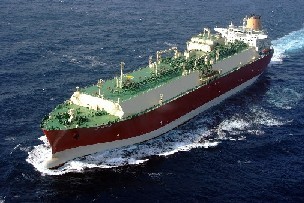

Home page|||
LNG handling |||
LPG handling||| Other Gas products|||
Fire & Safety|||
Emergency response |||
Encountering high winds and/or waves - Emergency response for liquefied gas carriers
If the vessel encounters a dangerous situation that may develop into an emergency, it is extremely important that the whole crew know exactly what they should do to save their lives and minimize damage.
The crew must be drilled to take certain actions more or less automatically. However, nobody must act without considering the superfluous consequences.
These plans should be used actively during emergency drills.
Encountering High Winds and/or Waves
Against the Weather
Consider - going slow-speed against the weather. This procedure has advantages and disadvantages. The disadvantage is that rolling is increased. The advantages are:
a) Less strain in the hull
b) Less hunting of main engine
c) Reduce of damages on deck by heavy seas
d) Reduce of bottom damage by slamming
When going against the weather the minimum strain will be obtained when the speed is just enough for keeping the vessel on course about 15 – 20 degrees off the wind direction.
Whilst alongside, Terminal regulations must be considered.

With the Weather
Consider - going slow-speed against the weather. This procedure has advantages and disadvantages. The disadvantage is that rolling is increased. The advantages are:
One alternative to going against the weather is going slow ahead with the weather. Advantages are:
a) Reduced danger of bottom damages and damages on deck
b) Less strain in the engine
The disadvantages are:
a) Risk of heavy sea breaking in over the poop
b) Risk of surfing, broaching and loss of steering control
c) Risk of torsion
When going with the weather, adjust speed to avoid surfing or broaching. Oil bags may be used to prevent the seas from breaking.
Drifting
When going with the weather, adjust speed to avoid surfing or broaching. Oil bags may be used to prevent the seas from breaking.
Drifting is another alternative when choosing the way of manoeuvring. The advantages are:
a) Least strain on the hull
b) No strain on the main engine
c) Less risk of heavy weather damages on deck
The disadvantages are:
a) Heavy rolling
b) Large volumes of water on deck
Consider - the metacentre height. If the vessel has a high metacentre height, the rolling will be violent with much water on deck. This may be avoided by going slowly astern in order to keep the stern up against the wind to reduce the rolling. Oil bags may be used to some advantage.
Turning
a) When going with the weather, adjust speed to avoid surfing or broaching. Oil bags may be used to prevent the seas from breaking.
b) When going with the weather it may become necessary for some reason to turn around to an opposite course against the wind. Such a turn must be carried out very carefully.
c) The manoeuvre must be started at the end of a wave train to obtain the calmest possible conditions. Reduce speed to a minimum.
d) Start the turn with the rudder hard over and increase engine power enough to have good steering control, but do not increase the speed of the vessel through the water.
e)The second part of the turn should be carried out with full engine power in order to meet the wave crest head on.
f) When the turn is complete, adjust the speed to sea conditions.
Anchor Dragging/Mooring Failure
a) Evaluate the situation. Weather condition and forecast, proximity of vessels in the vicinity, proximity from shore and grounding areas
b) Try to drop more chain
c) Try to drop second anchor
d) If considered necessary due weather conditions, ships in the vicinity dragging which may approaching dangerously, approaching to grounding areas or shore leave anchorage.
e) Remember to use main engine if you have difficulties to heave up the anchor
f) Inform CMSI, Agent and local Authorities if applicable
Related Information:
Abandonship procedures - Immediate Evacuation By Own Survival Craft
Collision accident - Emergency procedure for Liquefied Gas carriers
Salvage operation guideline
Cargo tank ruptures due to increased pressure - emergency procedure for gas carriers
Loss of power supplies - emergency actions
Risk and hazards of Equipment failure
Loss of Instrumentation during Unloading Operations - Recommended actions by Liquefied Gas carriers
Risk and hazards of Nitrogen Loss
Gas carriers Loss of Instrumentation during Loading Operations
Gas carriers Structural Damage due to Incorrect Loading/Unloading Sequence
Encountering High Winds and/or Waves - countermeasures
Safety guideline for changing previous cargo

// Home page///
LNG handling ///
LPG handling///
Sea transport ///
Gas products///
Cargo work
///Fire precautions
///Health hazards
///Safety Precautions
///Emergency response ///

Copyright © Liquefied Gas Carrie.com All rights reserved.
The content published in this website are for general reference only. We have endeavoured to make the information
as accurate as possible but cannot take responsibility for any errors. For latest information please visit www.imo.org .
Any suggestions, please Contact us !
///Links &Resources //
Terms of use///
Privacy policy///Home page///
